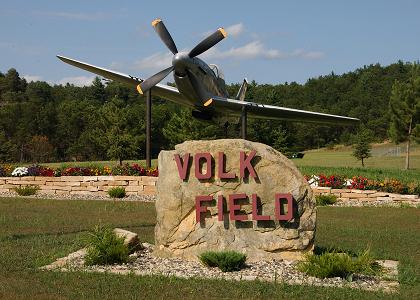 The origin of Volk Field CRTC can be traced back to 1888 when the State Adjutant General, General Chandler Chapman, purchased a site for a rifle range and offered it to the state for a camp. In 1889, the Wisconsin State Legislature authorized Governor William D. Hoard to purchase land near the site for a permanent campground and rifle range for the Wisconsin National Guard.
The origin of Volk Field CRTC can be traced back to 1888 when the State Adjutant General, General Chandler Chapman, purchased a site for a rifle range and offered it to the state for a camp. In 1889, the Wisconsin State Legislature authorized Governor William D. Hoard to purchase land near the site for a permanent campground and rifle range for the Wisconsin National Guard.
By 1903, the camp had expanded to over 800 acres and was used for training by the then reorganized National Guard. From that date until the Federal Call of 1916, the camp was frequently visited by officials from other states who came to observe the Wisconsin National Guard as a model to emulate.
The site was named Camp Williams in 1927 in honor of Lt Col Charles R. Williams, the Chief Quartermaster of the post from 1917 until his death in 1926. Camp Williams grew slowly following the First World War, but with the increasing development of the airplane, it was all but inevitable that an airstrip would be built. In 1935 and 1936, the first hard-surface runways were constructed.
In 1954, the federal government leased the field from the State of Wisconsin for use as a permanent field training site. That same year work began on the air-to-ground gunnery range near Finley, Wisconsin, eventually becoming Hardwood Range. In 1957, the Wisconsin Legislature officially designated the facility a Permanent Field Training Site and named it in memory of 1st Lt Jerome A. Volk, the first Wisconsin National Guard pilot killed in combat in the Korean conflict.
On June 13, 1990, the site was re-designated a Combat Readiness Training Center (CRTC). During the first Gulf War, from August of 1990 through February of 1991, Volk Field served a critical role as an Aerial Port of Embarkation (APOE) in support of Army deployments to the Gulf region. The 128th Air Control Squadron, Air Combat Maneuvering Instrumentation system (ACMI), Air Base Operability and Ability to Survive and Operate (ATSO) training missions were added in 1991.
During the 1980s and 1990s, exercises like Sentry Independence and Ready Norsemen were held at the installation, leading to today’s premier training exercise, Northern Lightning, that began in 2003.